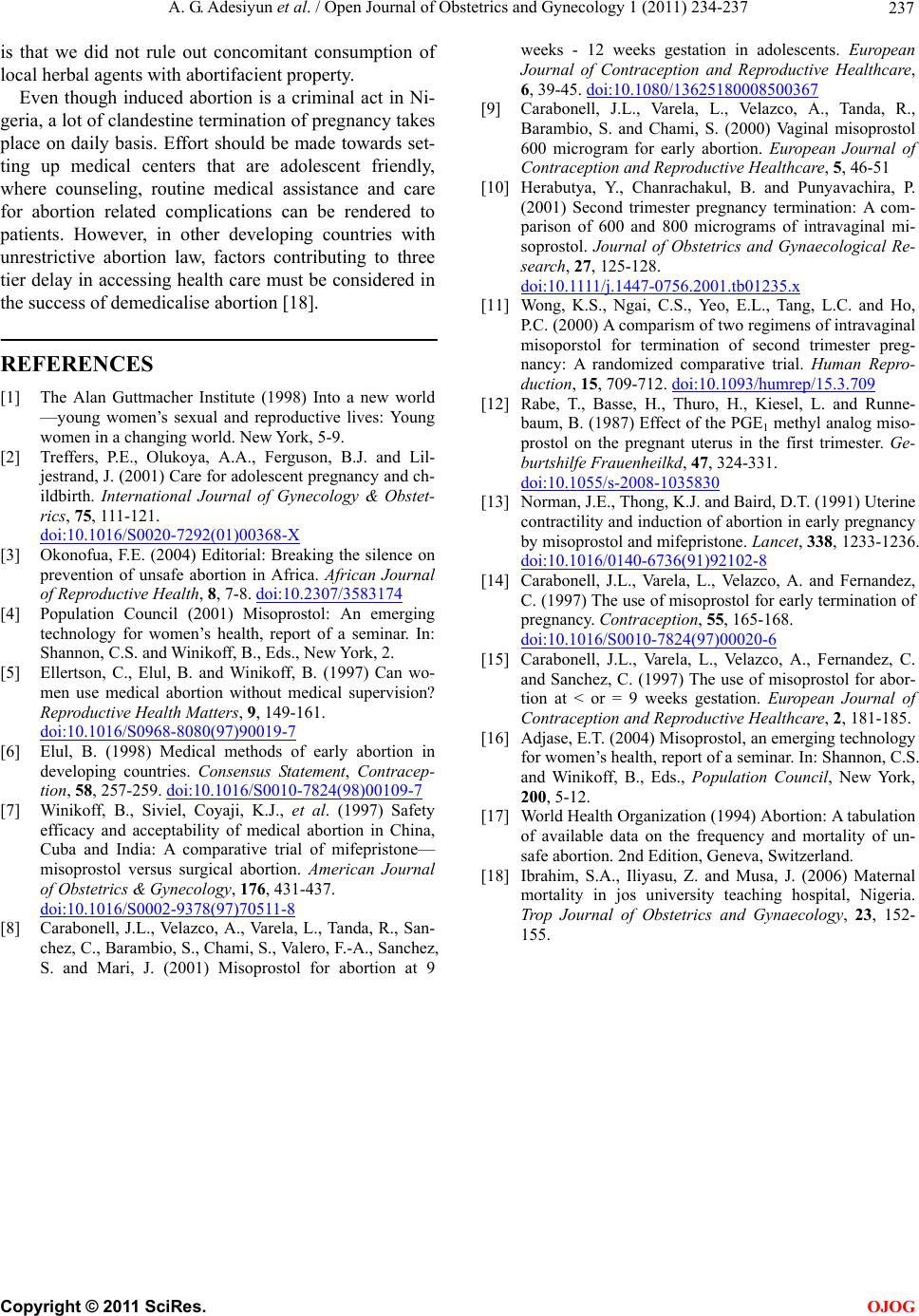
A. G. Adesiyun et al. / Open Journal of Obstetrics and Gynecology 1 (2011) 234-237
Copyright © 2011 SciRes.
237
is that we did not rule out concomitant consumption of
local herbal agents with abortifacient property.
Even though induced abortion is a criminal act in Ni-
geria, a lot of clandestine termination of pregnancy takes
place on daily basis. Effort should be made towards set-
ting up medical centers that are adolescent friendly,
where counseling, routine medical assistance and care
for abortion related complications can be rendered to
patients. However, in other developing countries with
unrestrictive abortion law, factors contributing to three
tier delay in accessing health care must be considered in
the success of demedicalise abortion [18].
OJOG
REFERENCES
[1] The Alan Guttmacher Institute (1998) Into a new world
—young women’s sexual and reproductive lives: Young
women in a changing world. New York, 5-9.
[2] Treffers, P.E., Olukoya, A.A., Ferguson, B.J. and Lil-
jestrand, J. (2001) Care for adolescent pregnancy and ch-
ildbirth. International Journal of Gynecology & Obstet-
rics, 75, 111-121.
doi:10.1016/S0020-7292(01)00368-X
[3] Okonofua, F.E. (2004) Editorial: Breaking the silence on
prevention of unsafe abortion in Africa. African Journal
of Reproductive Health, 8, 7-8. doi:10.2307/3583174
[4] Population Council (2001) Misoprostol: An emerging
technology for women’s health, report of a seminar. In:
Shannon, C.S. and Winikoff, B., Eds., New York, 2.
[5] Ellertson, C., Elul, B. and Winikoff, B. (1997) Can wo-
men use medical abortion without medical supervision?
Reproductive Health Matters, 9, 149-161.
doi:10.1016/S0968-8080(97)90019-7
[6] Elul, B. (1998) Medical methods of early abortion in
developing countries. Consensus Statement, Contracep-
tion, 58, 257-259. doi:10.1016/S0010-7824(98)00109-7
[7] Winikoff, B., Siviel, Coyaji, K.J., et al. (1997) Safety
efficacy and acceptability of medical abortion in China,
Cuba and India: A comparative trial of mifepristone—
misoprostol versus surgical abortion. American Journal
of Obstetrics & Gynecology, 176, 431-437.
doi:10.1016/S0002-9378(97)70511-8
[8] Carabonell, J.L., Velazco, A., Varela, L., Tanda, R., San-
chez, C., Barambio, S., Chami, S., Valero, F.-A., Sanchez,
S. and Mari, J. (2001) Misoprostol for abortion at 9
weeks - 12 weeks gestation in adolescents. European
Journal of Contraception and Reproductive Healthcare,
6, 39-45. doi:10.1080/13625180008500367
[9] Carabonell, J.L., Varela, L., Velazco, A., Tanda, R.,
Barambio, S. and Chami, S. (2000) Vaginal misoprostol
600 microgram for early abortion. European Journal of
Contraception and Reproductive Healthcare, 5, 46-51
[10] Herabutya, Y., Chanrachakul, B. and Punyavachira, P.
(2001) Second trimester pregnancy termination: A com-
parison of 600 and 800 micrograms of intravaginal mi-
soprostol. Journal of Obstetrics and Gynaecological Re-
search, 27, 125-128.
doi:10.1111/j.1447-0756.2001.tb01235.x
[11] Wong, K.S., Ngai, C.S., Yeo, E.L., Tang, L.C. and Ho,
P.C. (2000) A comparism of two regimens of intravaginal
misoporstol for termination of second trimester preg-
nancy: A randomized comparative trial. Human Repro-
duction, 15, 709-712. doi:10.1093/humrep/15.3.709
[12] Rabe, T., Basse, H., Thuro, H., Kiesel, L. and Runne-
baum, B. (1987) Effect of the PGE1 methyl analog miso-
prostol on the pregnant uterus in the first trimester. Ge-
burtshilfe Frauenheilkd, 47, 324-331.
doi:10.1055/s-2008-1035830
[13] Norman, J.E., Thong, K.J. and Baird, D.T. (1991) Uterine
contractility and induction of abortion in early pregnancy
by misoprostol and mifepristone. Lancet, 338, 1233-1236.
doi:10.1016/0140-6736(91)92102-8
[14] Carabonell, J.L., Varela, L., Velazco, A. and Fernandez,
C. (1997) The use of misoprostol for early termination of
pregnancy. Contraception, 55, 165-168.
doi:10.1016/S0010-7824(97)00020-6
[15] Carabonell, J.L., Varela, L., Velazco, A., Fernandez, C.
and Sanchez, C. (1997) The use of misoprostol for abor-
tion at < or = 9 weeks gestation. European Journal of
Contraception and Reproductive Healthcare, 2, 181-185.
[16] Adjase, E.T. (2004) Misoprostol, an emerging technology
for women’s health, report of a seminar. In: Shannon, C.S.
and Winikoff, B., Eds., Population Council, New York,
200, 5-12.
[17] World Health Organization (1994) Abortion: A tabulation
of available data on the frequency and mortality of un-
safe abortion. 2nd Edition, Geneva, Switzerland.
[18] Ibrahim, S.A., Iliyasu, Z. and Musa, J. (2006) Maternal
mortality in jos university teaching hospital, Nigeria.
Trop Journal of Obstetrics and Gynaecology, 23, 152-
155.